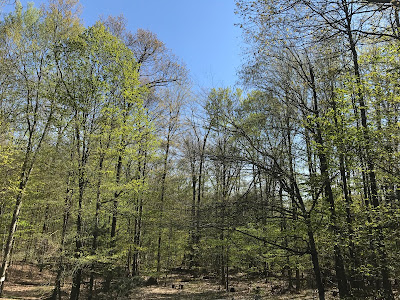May 18.
 |
| May 18, 2020 |
The rhodora is one of the very latest leafing shrubs, for its leaf-buds are but just expanding, making scarcely any show yet, but quite leafless amid the blossoms.
The Celtis occidentalis in bloom, maybe a day. Its shoots have grown two inches. It is as forward as the hickory at least; more than the elm.
A red clover in blossom.
A geranium budded; will open in a day or two.
Surprised to see a Ranunculus Purshii open.
A choke-cherry blossomed in a tumbler yesterday, and probably outdoors.
Finding the Linaria Canadensis yesterday at the Cliffs on a very close search for flowers makes me think that, by looking very carefully in the most favored and warmest localities, you may find most flowers out some weeks even in advance of the rest of their kind.
We have had no storm this spring thus far, but it mizzles to-night. Perchance a May storm is brewing.
This day it has mizzled — as it were a dewy atmosphere, through which for the most part the sun shines. Methinks this is common at this season of the tender foliage, which requires a moist air and protection against the sun.
A singular effect produced by a mass of ferns at a little distance, some rods square, their light yellow green tops seen above the dark masses of their fruit. At first one is puzzled to account for it.
White ash fully in bloom.
H. D. Thoreau, Journal, May 18, 1853
The rhodora is quite leafless amid the blossoms. See May 18, 1855 ("Rhodora; probably some yesterday.") May 18, 1856 ("The rhodora there maybe to-morrow. Elsewhere I find it . . . to-day."); May 18, 1857 ("Pratt says he saw the first rhodora . . . out yesterday") See also May 14, 1859 ('Rhodora out, says C."); May 17, 1853 (“The rhodora is peculiar for being, like the peach, a profusion of pink blossoms on a leafless stem. This shrub is, then, a late one to leaf out.”); May 17, 1858 ("Rhodora at Clamshell well out.”)
The Celtis occidentalis in bloom, maybe a day. Its shoots have grown two inches. See May 18, 1855 ("Celtis will probably shed pollen to-morrow; shoots already an inch long.") See also May 27, 1857 ("Celtis occidentalis, perhaps yesterday. How the staminate flowers drop off, even before opening!"); September 28, 1857 (" And they have cut down two or three of the very rare celtis trees, not found anywhere else in town. The Lord deliver us from these vandalic proprietors! The botanist and lover of nature has, perchance, discovered some rare tree which has sprung up by a farmer's wall-side to adorn and bless it, sole representative of its kind in these parts. Strangers send for a seed or a sprig from a distance, but, walking there again, he finds that the farmer has sent a raw Irishman. . . with axe and stub-scythe to exterminate it, and he will know it no more forever. . . .If some are prosecuted for abusing children, others deserve to be prosecuted for maltreating the face of nature committed to their care.")
A red clover in blossom. See June 12, 1854 (“Clover now reddens the fields.”); June 15, 1851 (“the clover gives whole fields a rich appearance, -- the rich red and the sweet-scented white. The fields are blushing with the red species as the western sky at evening.”); June 18, 1860 (“I see very distinctly the redness of a luxuriant field of clover on the top of Fair Haven Hill.”)
Finding the Linaria Canadensis yesterday at the Cliffs on a very close search for flowers makes me think that, by looking very carefully in the most favored and warmest localities, you may find most flowers out some weeks even in advance of the rest of their kind. See May 17, 1853 ("The low black berry, apparently, on Cliffs is out, earlier than else where, and Veronica arvensis, very small, obscure pale-blue flower, and, to my surprise, Linaria Canadensis."); May 22, 1855 ("Linaria Canadensis on Cliffs open.") See also February 28, 1857 ("It takes several years' faithful search to learn where to look for the earliest flowers."); April 10, 1855 ("As for the early sedge, who would think of looking for a flower of any kind in those dry tufts whose withered blades almost entirely conceal the springing green ones? I patiently examined one tuft after another, higher and higher up the rocky hill, till at last I found one little yellow spike low in the grass which shed its pollen on my finger. As for the saxifrage, when I had given it up for to-day, having, after a long search in the warmest clefts and recesses, found only three or four buds which showed some white, I at length, on a still warmer shelf, found one flower partly expanded, and its common peduncle had shot up an inch. These few earliest flowers in these situations have the same sort of interest with the arctic flora, for they are remote and unobserved and often surrounded with snow.") And see A Book of the Seasons,, by Henry Thoreau, the Earliest Flower
This season of the tender foliage, See A Book of the Seasons, by Henry Thoreau, May 18
Perchance a May storm is brewing. See May 17, 1852 ("Now the sun has come out after the May storm, how bright, how full of freshness and tender promise and fragrance is the new world!"); May 17, 1853 ("Does not summer begin after the May storm?”); May 19, 1853 ("A May storm, gentle and rather warm"); May 22, 1857 ("When the May storm is over, then the summer is fairly begun.");May 22, 1858 ("Something like this annually occurs. After this May storm the sun bursts forth . . . and we seem to have taken a long stride into summer.")





No comments:
Post a Comment